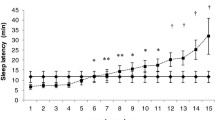Abstract
Purpose
This paper aims to compare the absolute performance of three noncontact sleep measurement devices for measuring sleep parameters in normal subjects against polysomnography and to assess their relative performance.
Methods
The devices investigated were two noncontact radio-frequency biomotion sensors (SleepMinder (SM) and SleepDesign (HSL-101)) and an actigraphy-based system (Actiwatch). Overnight polysomnography measurements were carried out in 20 normal subjects, with simultaneous assessment of sleep parameters using the three devices. The parameters measured included total sleep time (TST), sleep efficiency (SE), sleep-onset latency (SOL), and wake-after-sleep onset (WASO). The per-epoch agreement level for sleep/wake distinction was evaluated.
Results
The TSTs reported by the three devices were 426 ± 34, 434 ± 22, and 441 ± 16 min, for the SM, HSL-101, and Actiwatch, respectively, against polysomnogram (PSG)-reported TST of 391 ± 49 min. The SOLs were 10 ± 10, 5 ± 6, and 3 ± 2 min for the SM, HSL-101 and Actiwatch, respectively against PSG SOL of 19 ± 13 min. The WASO times were 46 ± 33, 43 ± 22, and 38 ± 17 min, as against PSG-reported 69 ± 46 min. All three devices had a statistically significant bias to overestimate sleep time and underestimate WASO and SOL compared with PSG. The performance of the three devices was basically equivalent, with only minor interdevice differences. The overall per-epoch agreement levels were 86 % for the SM, 86 % for the HSL-101, and 85 % for the Actiwatch.
Conclusions
Noncontact biomotion approaches to sleep measurement provided reasonable estimates of TST, but with a bias to over-estimation of sleep. The radio-frequency biomotion sensors provided similar accuracies for sleep/wake determination in normal subjects as the actigraph used in this study and slightly improved estimates of TST, SOL, and WASO.






Similar content being viewed by others
References
Blood ML, Sack RL, Percy DC, Pen JC (1997) A comparison of sleep detection by wrist actigraphy, behavioural response, and polysomnography. Sleep 20:388–395
Kushida CA, Chang A, Gadkary C, Guilleminault C, Carrillo O, Dement WC (2001) Comparison of actigraphic, polysomnographic, and subjective assessment of sleep parameters in sleep-disordered patients. Sleep Med 2:389–396
Morgenthaler T, Alessi C, Friedman L, Owens J, Kapur V, Boehlecke B et al (2007) Practice parameters for the use of actigraphy in the assessment of sleep and sleep disorders: an update for 2007. Sleep 30:519–529
de Souza L, Benedito-Silva AA, Pires ML, Poyares D, Tufik S, Calil HM (2003) Further validation of actigraphy for sleep studies. Sleep 26:81–85
Hedner J, Pillar G, Pittman SD, Zou D, Grote L, White DP (2004) A novel adaptive wrist actigraphy algorithm for sleep–wake assessment in sleep apnea patients. Sleep 27:1560–1566
Sivertsen B, Omvik S, Havik OE, Pallesen S, Bjorvatn B, Nielsen GH et al (2006) A comparison of actigraphy and polysomnography in older adults treated for chronic primary insomnia. Sleep 29:1353–1358
Paquet J, Kawinska A, Carrier J (2007) Wake detection capacity of actigraphy during sleep. Sleep 30:1362–1369
Blackwell T, Ancoli-Israel S, Redline S, Stone K (2011) Factors that may influence the classification of sleep-wake by wrist actigraphy: the MrOS sleep study. J Clin Sleep Med 7(4):357–375
Tryon WW (2004) Issues of validity in actigraphic sleep assessment. Sleep 27:158–165
Blackwell T, Redline S, Ancoli-Israel S, Schneider JL, Surovec S, Johnson NL et al (2008) Comparison of sleep parameters from actigraphy and polysomnography in older women: the SOF study. Sleep 31:283–291
Gagnadoux F, Nguyen XL, Rakotonanahary D, Vidal S, Fleury B (2004) Wrist-actigraphic estimation of sleep time under nCPAP treatment in sleep apnoea patients. Eur Respir J 23:891–895
Shouldice RB, Heneghan C, Petres G, Zaffaroni A, Boyle P, McNicholas W, de Chazal P (2010) Real time breathing rate estimation from a non contact biosensor. Conf Proc IEEE Eng Med Biol Soc 2010:630–633
de Chazal P, Fox N, O’Hare E, Heneghan C, Zaffaroni A, Boyle P et al (2011) Sleep/wake measurement using a non-contact biomotion sensor. J Sleep Res 20:356–366
Iber C, Ancoli-Israel S, Chessman A, and Quan SF (2007) The AASM manual for the scoring of sleep and associated events. American Academy of Sleep Medicine.
Krouwer JS (2008) Why Bland and Altman plots should use X and not (Y + X)/2 when X is a reference method. Stat Med 27:778–780
Lichstein KL, Stone KC, Donaldson J, Sidney DN, Soeffing JP, Murray D, Lester KW, Aguillard N (2006) Actigraphy validation with insomnia. Sleep 29(2):232–239
Montgomery-Downs HE, Insana SP, Bond JA (2012) Movement toward a novel activity monitoring device. Sleep Breath 16:913–917
Conflicts of interest
Emer O’Hare, David Flanagan, and Conor Heneghan are either present or past employees of ResMed Sensor Technologies. Equipment was provided free of charge by ResMed Sensor Technologies to Advanced Sleep Research for the purpose of this study. Thomas Penzel has received grants from Apnex, ImThera, Hoffrichter, Resmed, Philips, Somnomedics, Itamar, Weinmann. He is a shareholder of Advanced Sleep Research, Somnico, and The Siestagroup GmbH. For Carmen Garcia and Daniela Frohberg, there are no conflicts of interest.
Author information
Authors and Affiliations
Corresponding author
Rights and permissions
About this article
Cite this article
O’Hare, E., Flanagan, D., Penzel, T. et al. A comparison of radio-frequency biomotion sensors and actigraphy versus polysomnography for the assessment of sleep in normal subjects. Sleep Breath 19, 91–98 (2015). https://doi.org/10.1007/s11325-014-0967-z
Received:
Revised:
Accepted:
Published:
Issue Date:
DOI: https://doi.org/10.1007/s11325-014-0967-z



